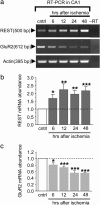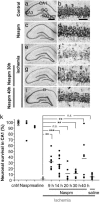Blockade of calcium-permeable AMPA receptors protects hippocampal neurons against global ischemia-induced death
- PMID: 16093311
- PMCID: PMC1189338
- DOI: 10.1073/pnas.0505408102
Blockade of calcium-permeable AMPA receptors protects hippocampal neurons against global ischemia-induced death
Abstract
Transient global or forebrain ischemia induced experimentally in animals can cause selective, delayed neuronal death of hippocampal CA1 pyramidal neurons. A striking feature is a delayed rise in intracellular free Zn(2+) in CA1 neurons just before the onset of histologically detectable cell death. Here we show that alpha-amino-3-hydroxy-5-methyl-4-isoxazolepropionic acid (AMPA)-type glutamate receptors (AMPARs) at Schaffer collateral to CA1 synapses in postischemic hippocampus exhibit properties of Ca(2+)/Zn(2+)-permeable, Glu receptor 2 (GluR2)-lacking AMPARs before the rise in Zn(2+) and cell death. At 42 h after ischemia, AMPA excitatory postsynaptic currents exhibited pronounced inward rectification and marked sensitivity to 1-naphthyl acetyl spermine (Naspm), a selective channel blocker of GluR2-lacking AMPARs. In control hippocampus, AMPA excitatory postsynaptic currents were electrically linear and relatively insensitive to Naspm. Naspm injected intrahippocampally at 9-40 h after insult greatly reduced the late rise in intracellular free Zn(2+) in postischemic CA1 neurons and afforded partial protection against ischemia-induced cell death. These results implicate GluR2-lacking AMPA receptors in the ischemia-induced rise in free Zn(2+) and death of CA1 neurons, although a direct action at the time of the rise in Zn(2+) is unproven. This receptor subtype appears to be an important therapeutic target for intervention in ischemia-induced neuronal death in humans.
Figures




Similar articles
-
Late calcium EDTA rescues hippocampal CA1 neurons from global ischemia-induced death.J Neurosci. 2004 Nov 3;24(44):9903-13. doi: 10.1523/JNEUROSCI.1713-04.2004. J Neurosci. 2004. PMID: 15525775 Free PMC article.
-
Remodeling of alpha-amino-3-hydroxy-5-methyl-4-isoxazole-propionic acid receptor subunit composition in hippocampal neurons after global ischemia.Proc Natl Acad Sci U S A. 2000 Nov 21;97(24):13360-5. doi: 10.1073/pnas.97.24.13360. Proc Natl Acad Sci U S A. 2000. PMID: 11087875 Free PMC article.
-
Knockdown of AMPA receptor GluR2 expression causes delayed neurodegeneration and increases damage by sublethal ischemia in hippocampal CA1 and CA3 neurons.J Neurosci. 1999 Nov 1;19(21):9218-27. doi: 10.1523/JNEUROSCI.19-21-09218.1999. J Neurosci. 1999. PMID: 10531425 Free PMC article.
-
The AMPAR subunit GluR2: still front and center-stage.Brain Res. 2000 Dec 15;886(1-2):190-207. doi: 10.1016/s0006-8993(00)02951-6. Brain Res. 2000. PMID: 11119696 Review.
-
Poly(ADP-Ribose)Polymerase 1 (PARP-1) Activation and Ca(2+) Permeable α-Amino-3-Hydroxy-5-Methyl-4-Isoxazolepropionic Acid (AMPA) Channels in Post-Ischemic Brain Damage: New Therapeutic Opportunities?CNS Neurol Disord Drug Targets. 2015;14(5):636-46. doi: 10.2174/1871527314666150430162841. CNS Neurol Disord Drug Targets. 2015. PMID: 25924998 Review.
Cited by
-
Involvement of GluR2 up-regulation in neuroprotection by electroacupuncture pretreatment via cannabinoid CB1 receptor in mice.Sci Rep. 2015 Apr 1;5:9490. doi: 10.1038/srep09490. Sci Rep. 2015. PMID: 25830356 Free PMC article.
-
Acid-sensing ion channel 1a drives AMPA receptor plasticity following ischaemia and acidosis in hippocampal CA1 neurons.J Physiol. 2015 Oct 1;593(19):4373-86. doi: 10.1113/JP270701. Epub 2015 Aug 18. J Physiol. 2015. PMID: 26174503 Free PMC article.
-
Mild acidosis enhances AMPA receptor-mediated intracellular zinc mobilization in cortical neurons.Mol Med. 2007 Jul-Aug;13(7-8):356-61. doi: 10.2119/2007–00047.Frazzini. Mol Med. 2007. PMID: 17622309 Free PMC article.
-
AMPA Receptor Dysregulation and Therapeutic Interventions in a Mouse Model of CDKL5 Deficiency Disorder.J Neurosci. 2019 Jun 12;39(24):4814-4828. doi: 10.1523/JNEUROSCI.2041-18.2019. Epub 2019 Apr 5. J Neurosci. 2019. PMID: 30952813 Free PMC article.
-
Neuroprotective properties of marrow-isolated adult multilineage-inducible cells in rat hippocampus following global cerebral ischemia are enhanced when complexed to biomimetic microcarriers.J Neurochem. 2011 Dec;119(5):972-88. doi: 10.1111/j.1471-4159.2011.07272.x. Epub 2011 May 13. J Neurochem. 2011. PMID: 21496021 Free PMC article.
References
-
- Lo, E. H., Dalkara, T. & Moskowitz, M. A. (2003) Nat. Rev. Neurosci. 4, 399-415. - PubMed
-
- Zukin, R. S., Jover, T., Yokota, H., Calderone, A., Simionescu, M., Lau, C. G. (2004) in Stroke Pathophysiology, Diagnosis, and Management, eds. Mohr, J. P., Choi, D. W., Grotta, J. C., Weir, B. & Wolf, P. A. (Churchill Livingstone, Philadelphia), pp. 829-854.
-
- Kirino, T. (1982) Brain Res. 239, 57-69. - PubMed
-
- Pulsinelli, W. A., Brierley, J. B. & Plum, F. (1982) Ann. Neurol. 11, 491-498. - PubMed
-
- Rosenbaum, D. M., D'Amore, J., Llena, J., Rybak, S., Balkany, A. & Kessler, J. A. (1998) Ann. Neurol. 43, 654-660. - PubMed
Publication types
MeSH terms
Substances
Grants and funding
LinkOut - more resources
Full Text Sources
Molecular Biology Databases
Miscellaneous

